Artificial intelligence (AI) is the latest innovation in technology that’s taken the world by storm. In the educational field, it’s an especially hot topic, with stories of diminishing cognitive skills and academic integrity violations among students who use this technology on the rise. And when it comes to English language arts, a subject that relies heavily on creativity and critical thinking, the advent of AI is certainly concerning.
To better understand this issue, we reached out to our ELA teacher subscriber base with a simple survey asking about their views on AI in the ELA classroom. All submissions were anonymous, giving respondents space to freely share their opinions. The final question gave them the option to write any additional thoughts they had about AI and its impacts in the ELA classroom. We’ll include some of those responses throughout this discussion.
Now, let’s see what they had to say!
Have you participated in any professional development workshops or seminars about AI and its place in education?
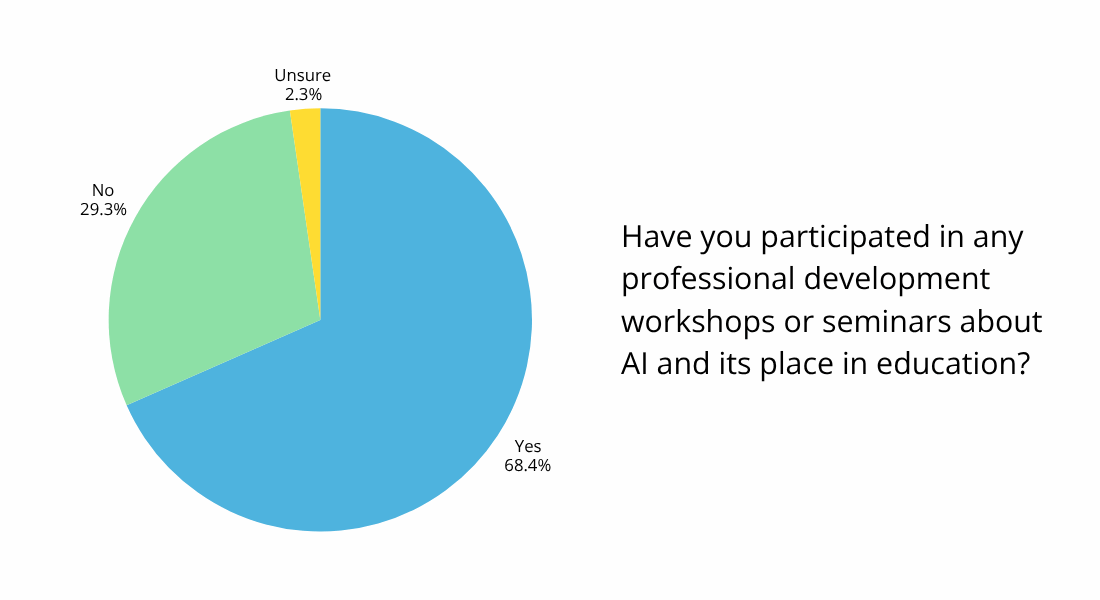
The goal of professional development (PD) workshops and seminars is to help teachers grow their teaching skills and learn about new techniques. With AI as ubiquitous as it is now, there are bound to be PD sessions on the subject taking place. When asked if they’ve participated in any PD workshops or seminars about AI and education, 68.4% of survey respondents said yes, 29.3% said no, and 2.3% weren’t sure.
Does your school or district have an official AI policy?
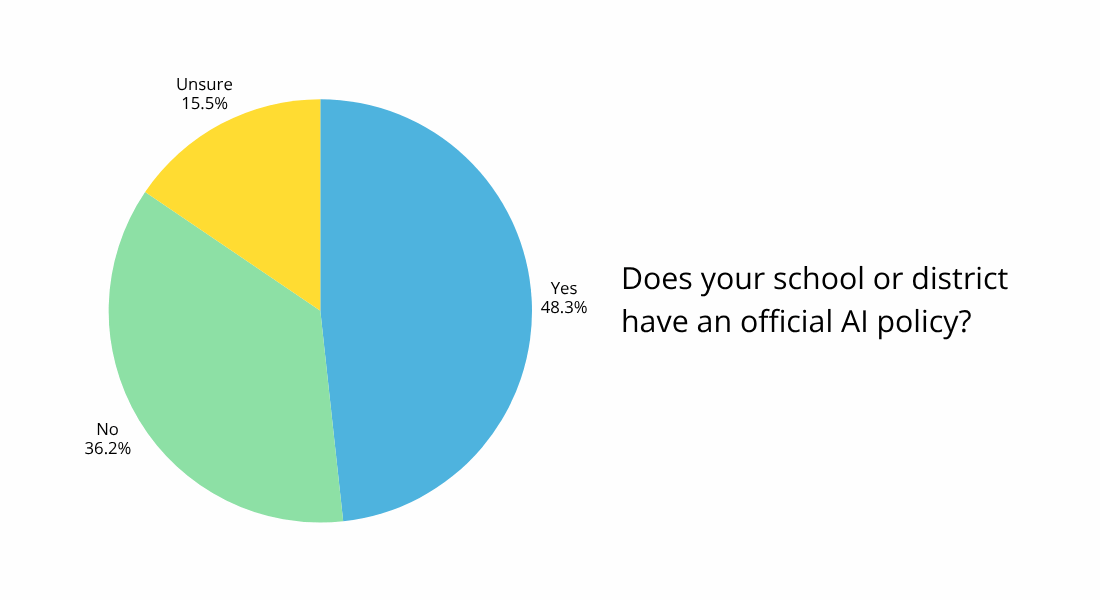
Because AI technology is relatively new among society at large, many schools and districts are still figuring out how to approach the technology. At the government level, there’s been a significant push for regulation, with more than half of US states releasing guidance to oversee how AI is used in public schools. But this guidance isn’t required by law for most schools, at least not yet. Just two states, Tennessee and Ohio, have passed official laws that make it mandatory for public school districts to create and publicly share AI-use policies.
With that information in mind, we asked survey respondents if their schools or districts have official AI-use policies. Answers were mixed, with 48.3% of respondents saying there’s a policy, 36.2% saying there isn’t, and 15.5% were unsure.
One respondent gave a specific example of their school’s AI policy and its consequences for cheating:
“At our school, if they are caught, it is an automatic zero on the assignment and disciplinary action for cheating (sent to the office for the principal to address).”
Some ELA educators have taken charge and established guidelines themselves at the department level. But if the rest of the school’s departments don’t adhere to the same standards, then the rules are harder to enforce:
“I've created a department policy based on what the University of Minnesota does. AI is frustrating, in part because it significantly reduces critical thinking. In the practical, other departments don’t check if something is original or AI-produced. It makes a hard job even more difficult.”
Regardless of whether or not your school or district has an official AI policy, do you allow students to use AI programs in your class?
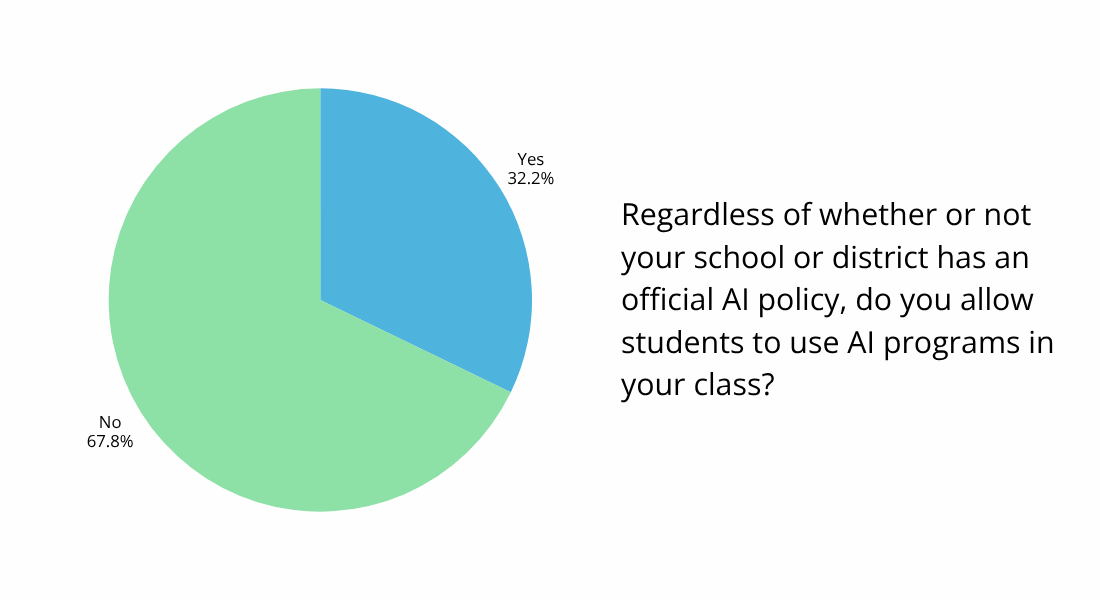
Next, we asked teachers if they let students use AI programs in class even if there isn’t a school- or district-wide policy in place. In the survey, we gave examples of AI programs that included educational programs (e.g., SchoolAI, MagicSchool), chat programs (e.g., ChatGPT, Claude), text generation tools (e.g., DeepAI, Quillbot), image generation tools (e.g., Midjourney, Adobe Firefly), and AI assistants (e.g., Google Gemini, Microsoft Copilot).
The majority of respondents (67.8%) said they do not allow students to use AI programs in class. The remaining 32.2% of respondents said they do.
Several respondents who let students use AI mentioned how they see AI as a tool for improving work, but not for completing entire assignments. This teacher explains:
“My goal is to teach the students how to use AI appropriately. I encourage them to use AI when brainstorming for essays, research projects, etc. This does not mean that they are simply copying and pasting the results in place of writing/creating their own work. AI doesn’t provide ‘voice’ very well, and depending on the purpose of the writing, AI may not provide the correct mood and/or ‘voice.’”
This respondent said AI programs are prohibited at the district level, which makes it impossible to use certain tools to help students grow their skills:
“Our district blocks use of AI—students cannot access it at school. I would like to teach students to use it as a tool, such as feedback on their work to improve and such, but it is not an option at this time.”
How often do you use AI programs or tools for your job?
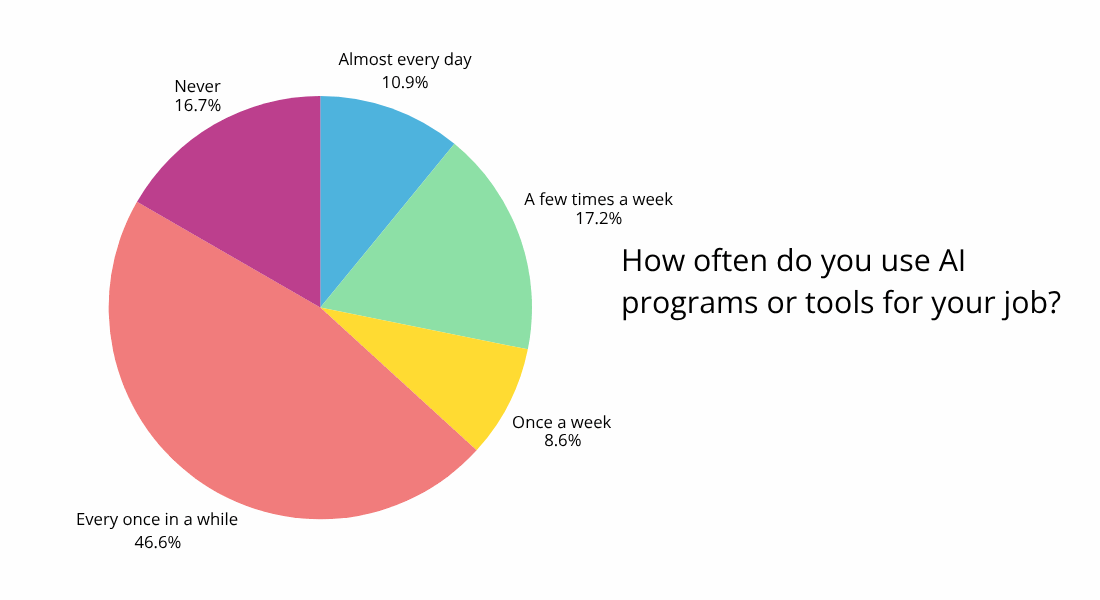
We know students are definitely using AI for schoolwork, but what about teachers? We asked how often they use these programs for their jobs. 16.7% of respondents said they never do; 46.6% said every once in a while; 8.6% said once a week; 17.2% said a few times a week; and 10.9% said almost every day.
According to some respondents, the use of AI to automate teaching tasks may be doing more harm than good:
“I have a colleague who uses AI to grade, and students reported that 1) they knew it was AI, and 2) it resulted in the worst grades they’d ever received for their writing.”
“I do not approve of the use of AI in the classroom, especially at a middle school level. Middle school is where students start to practice and develop their critical thinking and writing skills. If we give them tools to rely on before they can learn to do it themselves, they may never truly learn these crucial skills. Letting them use AI to write something tells me nothing of what they are actually capable of. There are also the issues that are created when teachers use AI. Many of the teachers at my school who rely on AI never bother to check over their assignments or rubrics; this often results in assignments and rubrics that are not appropriate/accurate for what is being done in the classroom.”
How often do you use AI programs or tools outside of work?
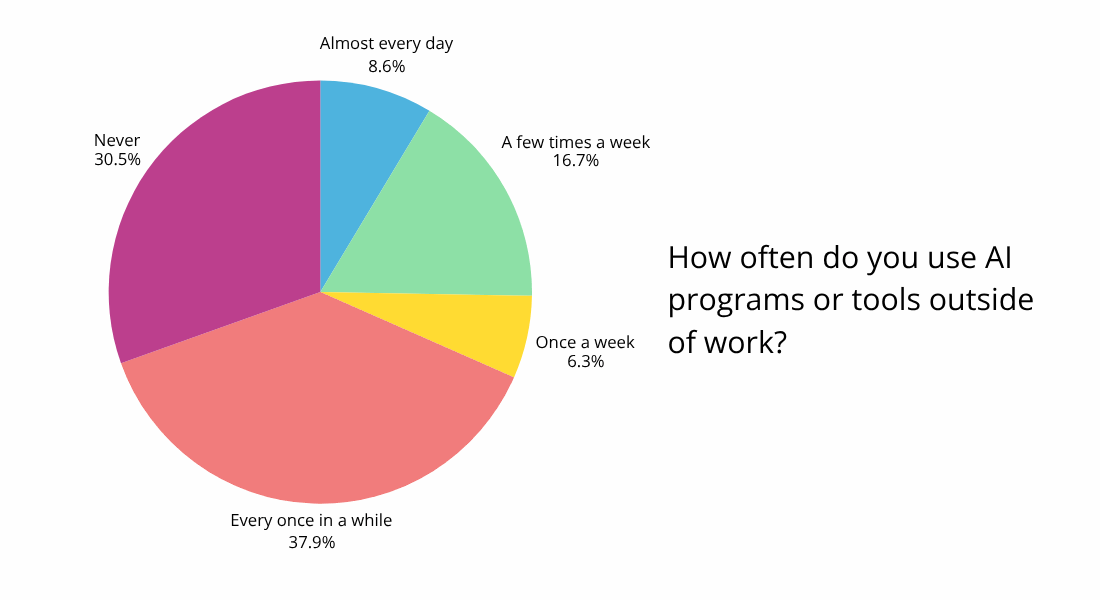
AI isn’t just affecting the school environment; it’s also changing the way we interact with technology on an everyday basis. When asked how often they use AI programs or tools outside of work, 30.5% of survey respondents said they never do; 37.9% said every once in a while; 6.3% said once a week; 16.7% said a few times a week; and just 8.6% said almost every day.
Generational differences also play a part when it comes to the adoption of these tools and programs. Older generations know what life was like without this type of technology, but today’s kids are surrounded by it. One respondent mused:
“I think it’s a great tool for teachers to save time! However, we still need to teach the kids to do things the old-fashioned way. It’s great for us teachers, but we know how to do it the old-fashioned way already and could survive if all technology crashed tomorrow. Students of today may not know how to live without the tech, which could pose a very big problem in the future should things go awry.”
What is your general outlook on the use of AI programs in the ELA classroom today?
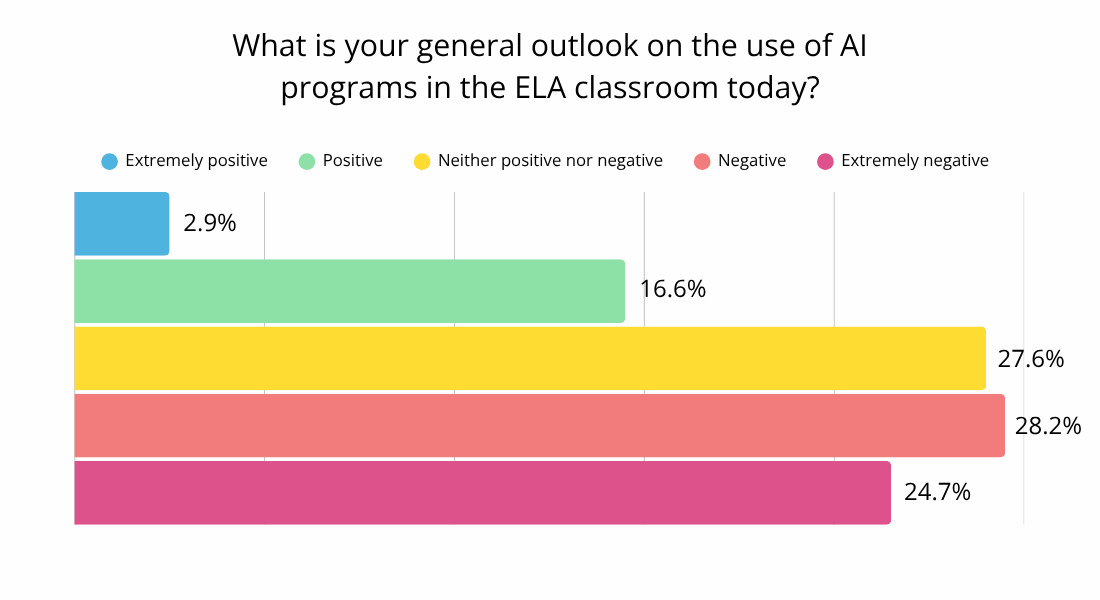
Just 2.9% of respondents had an extremely positive outlook on the use of AI in the classroom; 16.6% viewed it as positive; and 27.6% were neutral.
“I’m still negotiating how to best present and teach AI use as a resource rather than a crutch. Our district has banned any AI-based websites including helpful ones which I have previously used to teach responsible MLA and APA citation generation. Ultimately, I think it’s important to be proactive rather than reactive when it comes to AI in both K-12 and higher education classrooms.”
The majority of respondents skewed toward the negative side, with 28.2% choosing negative and 24.7% picking extremely negative.
“Children should not be taught how to use AI in school. We should instead be focusing on increasing the value of independent, critical thought. Students can learn appropriate ways to use AI in their workplaces or after graduation. ChatGPT and its counterparts do nothing but make our students less capable human beings.”
What potential benefits do you think the use of AI tools could add to the ELA classroom?
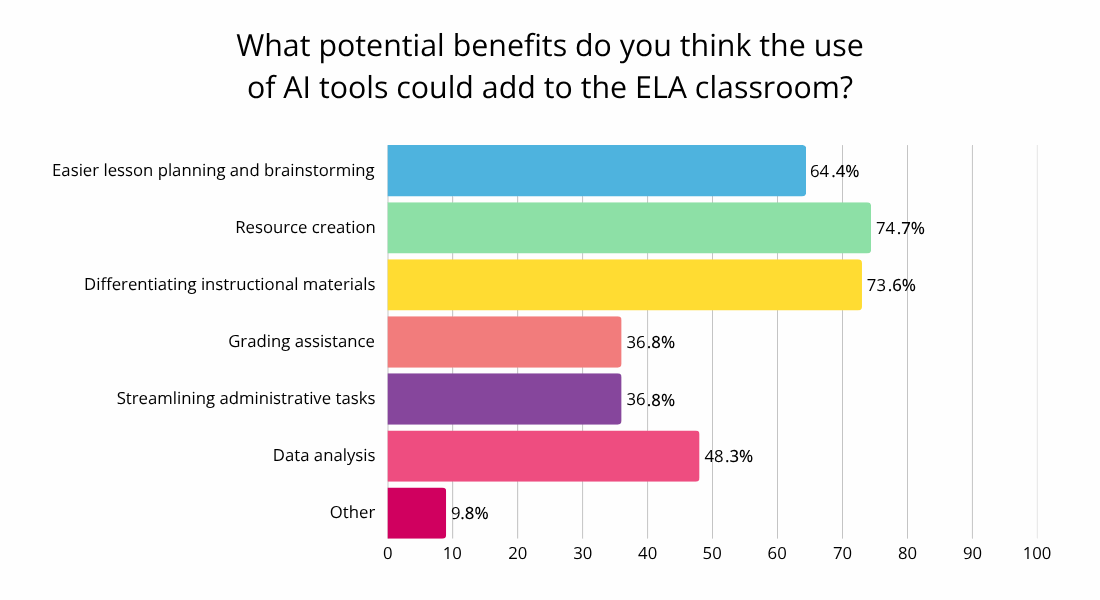
Like any tool, AI programs do have potential benefits, even if the technology itself is contentious. We presented survey respondents with a few potential ways in which AI tools could benefit the ELA classroom. Resource creation was the most popular at 74.7%, followed closely by differentiating instructional materials at 73.6%. Next were easier lesson planning and brainstorming at 64.4% and data analysis at 48.3%. Grading assistance and streamlining administrative tasks were tied at 36.8%.
9.8% of respondents filled out the “Other” option. Many stated how AI programs can help them generate custom resources and lessons for different student groups, such as high-performing students, English language learners, and special needs classes.
“I use it for translation to make the education of my language learners more equitable.”
“I enjoy creating Study Bots through MagicSchool as an extra resource for my students. Please note that I do not use AI as a replacement for my teaching.”
Several survey respondents didn’t select any benefits. One offered this viewpoint instead:
“No potential benefits outweigh the risks. As ELA teachers, we should be the loudest voices against AI, not trying to incorporate it.”
Which brings us to our next question …
What potential concerns do you have about the use of AI tools in the ELA classroom?
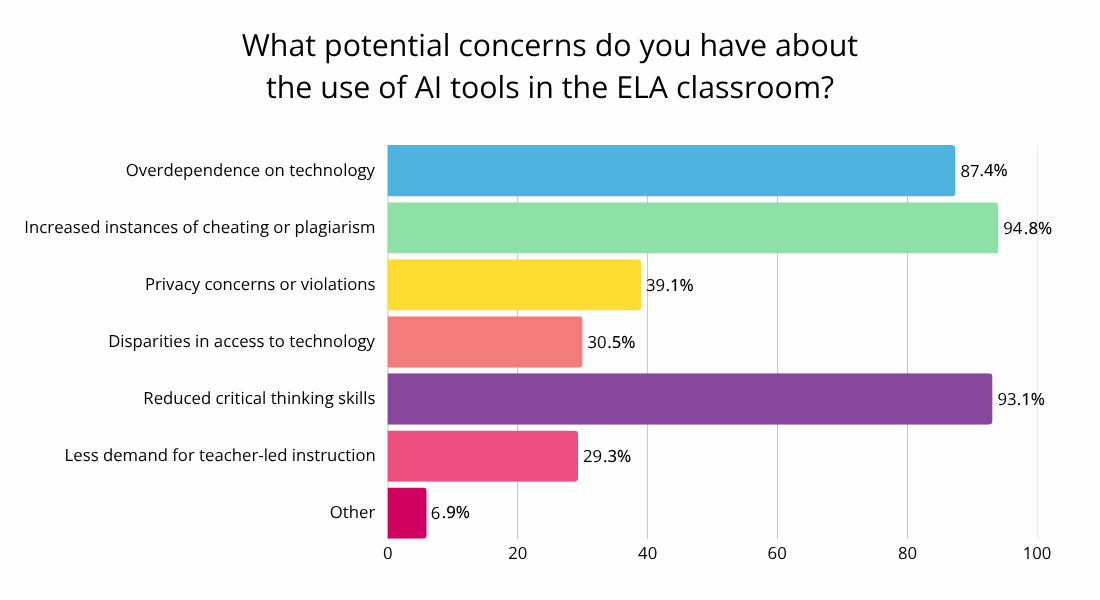
There are many valid concerns about AI in the ELA classroom. Among the given options, the most popular concern was increased instances of cheating or plagiarism at 94.8%. Reduction in critical thinking was a close second, with 93.1% of respondents choosing this answer.
“We are supposed to be building critical thinking skills and media literacy with our students. By allowing them to have a machine do all the thinking for them, their critical thinking skills plummet, they are unable to look at texts, articles, and media with a critical lens, and their entire voice is lost and replaced with AI slop.”
Overdependence on technology came in third at 87.4%, followed by privacy concerns or violations (39.1%); disparities in access to technology (30.5%); and less demand for teacher-led instruction (29.3%).
“It can be a wonderful tool, but high school students do not know how to think critically to use it properly. We must teach children how to think critically! The temptation is too great, and children will allow AI to do the ‘thinking’ for them.”
6.9% of those surveyed chose the “Other” option and shared specific concerns they have. Common responses included the impact of AI on the environment, job loss in the educational field, the long-term effects of AI usage on our brains, and AI sharing inaccurate or misleading information, sometimes referred to as “hallucinating.”
In the past year, have you caught students using AI to cheat?
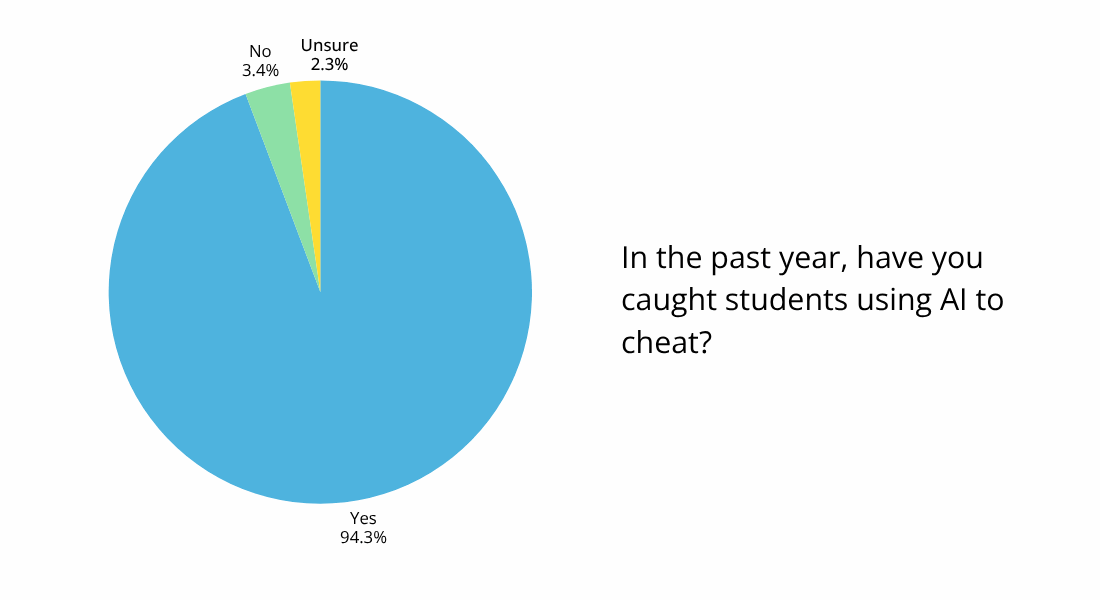
Based on the responses to the last question, the results for this one aren’t surprising. When asked if they’ve caught students using AI to cheat in the past year, a whopping 94.3% of teachers said yes. Just 3.4% said no, and 2.3% weren’t sure.
One respondent mentioned how some students can’t determine whether using AI to assist with assignments counts as cheating or not:
“Students have a hard time understanding what is considered cheating, so even those who wouldn’t cheat are using AI inappropriately; I need to be incredibly explicit about when and how AI is allowed in order to ensure that even students who are willing to follow rules do not use AI for lessons in which its use would be considered cheating.”
In the past year, have you altered lesson plans to be “AI-proof”?
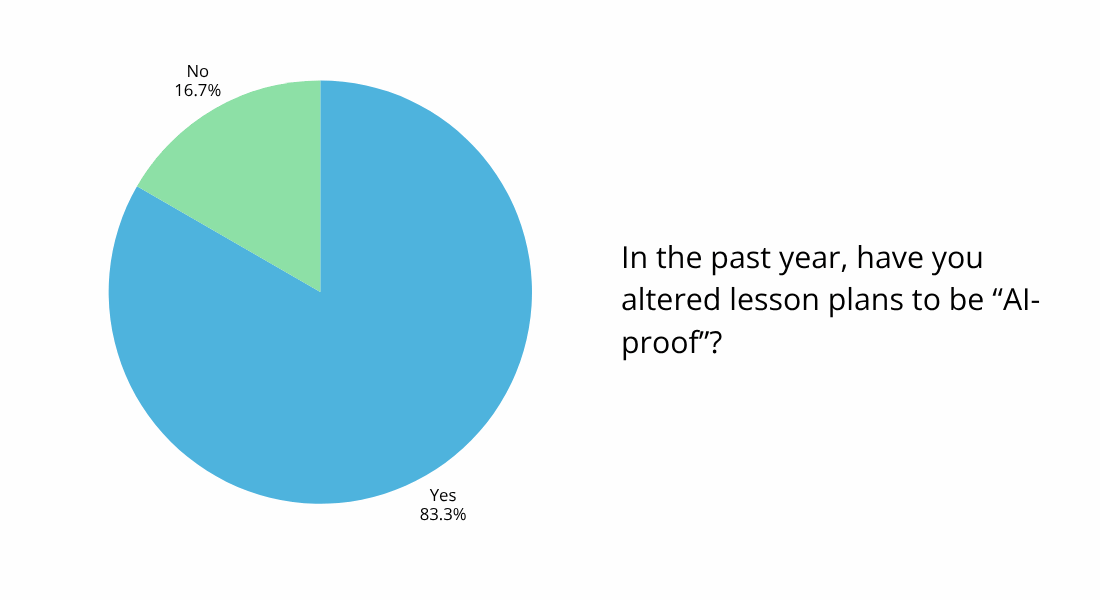
With cheating on the rise, educators are looking for ways to make assignments and lessons “AI-proof.” In the past year, 83.3% of survey respondents have altered their lessons; 16.7% have not.
What makes a lesson or assignment “AI-proof?” It’s easy for students to copy and paste assignments or writing prompts into a program like ChatGPT and have it generate a product for them. To avoid this, AI-proof assignments focus less on the final product itself and more on the process of thinking and producing the work. For instance, many teachers now require writing assignments to be handwritten in class instead of typing them at school or at home. This respondent stated:
“I have gone back to hand writing rough drafts. Students do not like it, but going back to the messiness of writing helps them in understanding what they are writing.”
This respondent noted how AI-proof assignments reveal cracks and gaps in students’ academic output:
“I have seen first hand the students who rely on AI to complete their assignments do notably worse on AI-proof assignments. It is affecting their ability to think for themselves.”
Some teachers are using a hybrid approach, letting students use AI as a starting point for activities but moving the actual production process to tangible, physical work:
“I show students how to use AI as a tool, not a source. I teach them how to use it for brainstorming, or help with an outline and then they are to do the writing on paper with a pen/pencil.”
Do you have anything else you’d like to share about your experiences with AI in the ELA classroom?
At the end of the survey, we asked teachers to share any additional thoughts about AI and ELA education. We received many interesting responses that covered a vast spectrum of opinions. Let’s look at some of them now.
Several respondents explained that AI is here to stay, so it’s important for teachers to learn more about the technology and guide students towards responsible use.
“Pandora’s box. It’s not going away, so teachers must find a way to deal with it.”
“I believe AI will have a permanent place in the classroom. I also believe it is our responsibility as educators to help our students understand the benefits (and downfalls) to using AI. Most students think the only way to use AI is to tell it what they want and wait for AI to generate something they can copy and paste.”
“I think it’s important to teach students about AI—not how to use it, but the larger ethical concerns and how it impacts their learning and development, for both good or bad. Despite the rising concerns about everything from environmental impacts to decreased knowledge retention to increasing social isolation, these tools are probably not going away. We all have a responsibility to think critically about our use of them. Simply making lessons ‘AI-proof’ leaves many larger issues unaddressed.”
“I’m torn. If given guidelines and instructed on effective and acceptable use, AI can be very beneficial to students… the same way I use it as a teacher.”
Other respondents expressed concerns about the impact on students and skill development.
“I think in theory it may sound good, but in the long run it will prove to be detrimental to learning.”
“We have students using AI to analyze the literature we are reading in class instead of using their own abilities. This is concerning because students need to develop analytical abilities.”
“Although there are a FEW ways we can integrate responsible use of AI, for the most part, our students do not need access to AI to create our assignments. AI (used responsibly) has a few benefits; however, as an educator, I already know how to complete the tasks that I use AI for. I use it when I am in a time-crunch. The students do not yet have the skills we are teaching, so they do not need to rely on AI to ‘help’ them with the assignments. They MUST have the basic skills mastered before they can use AI to help tweak work or to create something new.”
These respondents observed that AI is being adopted too quickly with little oversight or consideration into its long-term ramifications.
“Our school is experiencing a push from some parents and our marketing department to find ways to use AI. I’m concerned that our society is rushing into using this technology in the absence of guidance/best practices and disregarding the potential negative consequences.”
“Beyond the dehumanization evident in AI and the diminution of critical thinking, there is also an environmental cost. I think the rush by many to embrace or get ahead of the AI movement is misguided and potentially very harmful.”
The Future of AI and the ELA Classroom
You may be wondering what the Prestwick House team thinks about AI and the ELA classroom. When it comes down to it, learning—and teaching—is an inherent part of the human experience. No technology can ever replace the incredible work educators like you do in the classroom each and every day. We think this teacher’s response sums up our sentiments well:
“If we are too willing to let computers do our critical thinking and creative tasks, soon there will be no more need for us and computers will do everything. If students are willing to let computers do their thinking, they are also okay with a computer taking their job one day. If we as teachers get too comfortable with using computers to do all parts of our jobs, we will one day become obsolete as well. Teaching is a human profession and learning is done best with human connection.”
Well said.
Thank you to all of our survey respondents. Your opinions are always appreciated! We’d love to hear from you again in the future, so please keep an eye on your email inbox for more survey opportunities.
5 Sci-Fi Stories to Spark Classroom Discussions on AI
What better way to approach the use of AI in the ELA classroom than by diving into some great literature about it? These five science fiction tales offer unique viewpoints on the concept of AI and the technology’s impact on human nature, morality, ethics, and more!
Read More